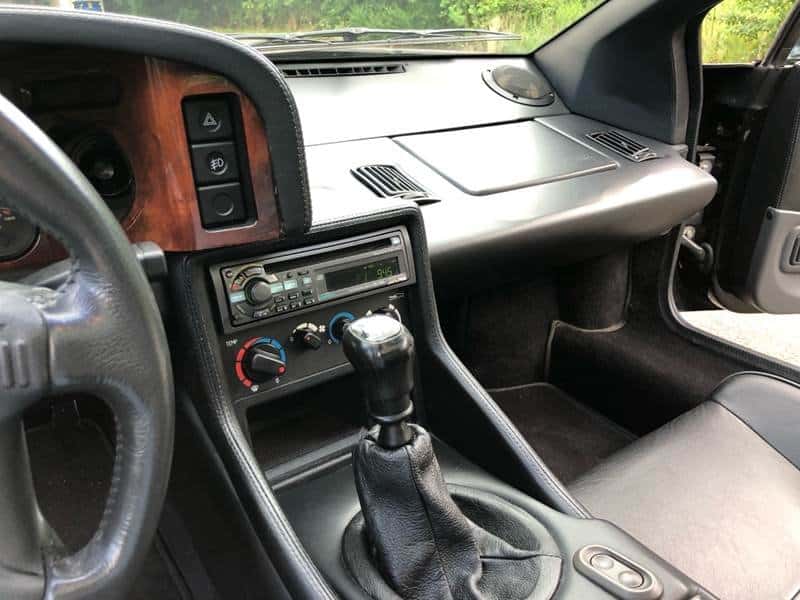*Seller Asking:
$33,980

- The Esprit V8 replaced the 4 cyl S4 Esprit. The new twin turbo V8 was developed in house by Lotus, known as the Type 918. The small 3.5L displacement is partnered with two Garrett T25/60 turbochargers providing 10 lbs of boost, allowing the Esprit to easily out-gun Ferrari’s F355
- The DOHC Type 918 V8 is an all-aluminium, 4 valve per cylinder design. The flat-plane crankshaft and oversquare bore/stroke allow a steep redline of 7400 RPM, despite the limitations of forced induction
- After recently helping GM develop the quad cam LT5 V8 for the Corvette ZR-1, Lotus learned an important lesson: keep things simple. The complex, highly advanced LT5 proved to be a massive development headache (despite how impressive it was), so Lotus decided to take the opposite approach for their own quad cam V8. John Owen, Esprit project manager, insisted the V8 be made up of no more than 250 different parts (an engine of this caliber usually consists of ~400 part numbers). Owen also insisted that there be no more than one inch of unused cubic space anywhere in the engine
- The resulting V8 was so compact that it could fit neatly within the same engine bay space as the old 2.2L 4 cylinder, plus room for two turbos. In fact, the capacity of the adjacent cargo area increased with the V8 model. In addition, it weighed only 15% more than the 4 cyl while making 50 more horsepower
- The V8 is capable of 525 hp in GT1 race configuration, simply with the help of VVT, intercoolers, and an increase in displacement to 4.0L. Unfortunately, Lotus had to limit power in street form to preserve the Renault designed 5spd transaxle
- The ZR-1 project gave Lotus first hand experience with Chevrolet’s strict durability testing and engine life requirements. Looking to provide the same durability as the LT5, Lotus chose to run cast iron cylinder liners in their aluminum block (this is at a time when most Italian exotics were running sleeveless aluminum engines for weight savings). In addition, the Lotus V8 employed 4 bolt main caps (with cross bolt pattern), forged steel connecting rods, and a forged steel flat plane crankshaft
- Despite all this, Lotus decided against forged pistons, an intercooler, or a blow off valve. They instead relied on their ECU (developed in-house) to control boost and promote engine longevity
- First official model year of the Esprit V8 (the V8 was sold in 1996 as a 1997 model. The 1996 MY was reserved for the 4 cyl GT3 S4)
- The V8 saw many changes over the S4, including a re-calibrated ECU, re-tuned suspension, and a new 4-channel ABS system tuned to provide greater stability and more feedback to the driver
- Features a new lightweight flywheel and low inertia twin plate clutch assembly. Includes cast iron clutch housing and clutch pedal stop
- Aero updates include new rear wing and front valance panel
- Cosmetic updates include dual exit exhaust, and new AWI 6 spoke wheels. Build dates after October featured revised interiors
- A new high-efficiency A/C system was added as well
- The following year (1998) saw the 4 cyl GT3 dropped. The V8 is now offered in 2 trims: GT (base model) and SE (fully loaded, £10,000 more)
- Fun fact: the rear taillights of 1993 and newer models were borrowed straight from the Toyota AE86. This was during the early stages of the Lotus-Toyota relationship
–
Seller Notes:
- All stock
- Impeccably maintained, including a brand new clutch
- Call for more info
- Location: Homewood, Alabama – (more photos below)
- Update: car has sold

To list your own car, contact us HERE.
*SAE rated from factory. May not reflect current output
*Performance numbers pulled from reputable automotive road tests
*Base price when new does not reflect original MSRP of this particular car, nor does it reflect what the original owner paid for it
*Advertised price at time of posting. Sellers can raise or lower prices on their original ad at any time. Click on the original ad to view current price/availability
Mileage Disclaimer: NOC has not confirmed if the mileage stated by the seller is true and accurate. It is up to the buyer to verify these claims. Vehicle history reports, service records stating mileage, and even inspections of odometer tampering are recommended.








